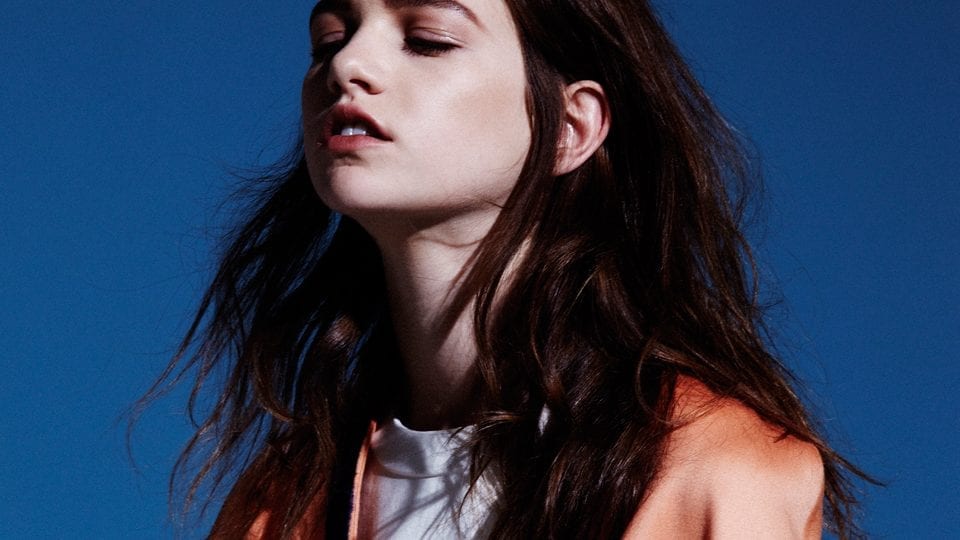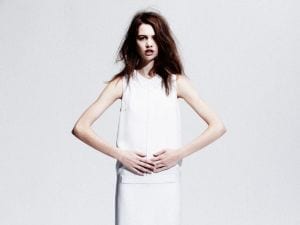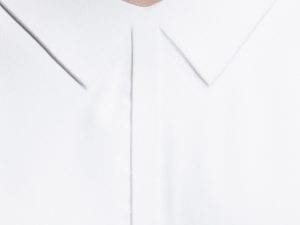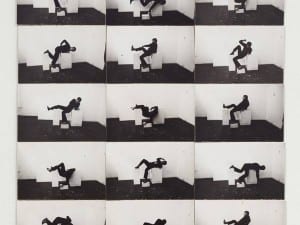One of London Fashion Week’s 2017 LAUDED Designers looks to the future of expression, which is influenced by neutrality, functionality and longevity.
Minimalism is hard to escape right now. Whether it’s books imploring us to throw away half our wardrobe, or Instagram accounts advocating a simple life through the accompanying hashtag, less really does appear to be more. In fashion, however, simplistic tailoring and clean lines have a heritage that runs far deeper than any social media trend. Emerging South Korean designer Jackie Lee takes inspiration from the long tradition of bespoke menswear in order to create sophisticated, flowing pieces for her own brand, J. JS Lee.
Lee is originally from Seoul, where she spent five years as a senior pattern cutter. After moving to the United Kingdom in 2007, Lee studied at Central Saint Martins in London. Here, she completed a postgraduate course in innovative pattern cutting and followed this with an MA in womenswear. Alongside this, she continued to hone her skills working as a master pattern cutter for KISA London. This experience, she explains, “hugely helped me to understand structure.”
With her technical skills firmly in place already, her experience at Central Saint Martins was largely about finding herself as a designer. She describes “struggling” to work out her identity, and credits her studies in aiding this sense of development. She decided that she would design “exactly what I liked, and focus on what I was good at.” This ethic, essentially one of focused simplicity, is reflected in the aesthetics of the resulting clothes. Lee dubs the style “cleanism” rather than minimalism, but many of the original concept’s key tenets are in place: the label is “not focused on seasonal trends or fast fashion,” but instead places an emphasis on quality, structure and unique detailing.
Despite her uncertainties about whether or not she had managed to find a “distinguished style” when she graduated, Lee quickly found success, with positive industry feedback coming straightaway, and – although she had not initially expected to launch it immediately – the beginning of her own label in 2010. Doing what she felt comfortable with has, she believes, fostered a deep sense of connection with her own identity and design ethos that is key to her continuing growth. Her clothes appear to be imbued with this self-contained assurance: they are simplistic but no less exciting for it, with their clean tailoring allowing the interesting lines, clever use of colour and the intricate detailing to sing.
To date, London has played a major role in Lee’s career. The city, where she sees a “co-existence of elements … old and new, historical and contemporary art, classic and new technology” – seems to serve as a constant inspiration. She says emphatically: “London is one of the most influential cities in the world.” In 2011, she received sponsorship from the British Fashion Council’s NEWGEN scheme, which is driven by a commitment to “nurturing emerging talent” in the capital. This experience was a formative one for Lee: NEWGEN’s mentoring scheme, specifically, and the exposure that it offered, more generally, gave her the support mechanisms that are lacking to so many emerging designers.
The city also, of course, hosts the eponymous Fashion Week, which is a vital means of showcasing the work of both new and established designers. For Lee, London Fashion Week’s (LFW) influence is important in both practical and aesthetic terms. It is, she recognises, “one of the major activities” in the industry, and a major leader of trends. However, it also encourages her to be ambitious – as she says, “to create new designs without any limits.” It is hard to underestimate the importance of LFW and the wider contribution of fashion weeks in general when it comes to emerging designers. Evidently, the inspiration these events provide, as well as the exposure for those practitioners featured, is crucial to the industry’s ongoing development. The shows seem to be changing, though – modernising, perhaps – with an increasing investigation into pieces that can be purchased straight from the show. Burberry were first to offer this innovation, announcing in early 2016 that from September onwards, customers would be able to access all the brand’s garments immediately. In some ways, this reflects the impatience of the culture surrounding contemporary fashion. Waiting months for pieces to become available does not necessarily appeal to a generation of consumers more accustomed to instant gratification.
This shift, which has the potential to create profound changes, may seem like “fast fashion” in action, but in many ways is actually its antithesis. The schedule of shows means that clothes were, previously, showcased well before the season for which they were designed. Making clothes immediately available represents a move away from this rigidly structured seasonal approach, which actually reflects a philosophy taken by many younger brands. Lee is far from the only designer to reject seasonal trends. A growing awareness surrounding ethical manufacture is encouraging buyers to consume – in a phrase that resounds quite clearly with minimalism – “less, but better.” Fast fashion is increasingly portrayed as wasteful. This provides a solution to one of the difficulties Lee has previously encountered with designing for LFW: finding a balance between “show styles” and “commercial styles.” The instant availability of pieces will, in all likelihood, begin to reduce the importance previously attached to this difference.
As seasonal distinctions are beginning to fade, so too, perhaps, are conventional notions of male and female fashion. Lee’s sophisticated shapes and lines quite explicitly draw their inspiration from menswear, and indeed she deliberately chooses to present “a masculine aesthetic in a feminine way, or the other way around. I use men’s suiting fabrics with feminine details, such as laces or prints, or very flowing fabrics in bespoke tailoring.” Her clothes clearly appeal to all genders: she describes how her male clients “love to try on my coats, shirts and jackets and I do sell to them. It is fun to see male customers buying my collection.”
Androgynous fashion has a long and radical pedigree. Whether for practical reasons (women working in munitions factories during WWI needed clothes that would be easy to move in, work in, and concurrently safe around dangerous machinery) or to make a stylish political point, the simple act of donning a pair of trousers – or any clothing atypical for one’s gender – has been a subversive statement. Think of David Bowie performing Starman on Top of the Pops in 1972. Wearing a catsuit, with big hair, make-up, and an arm draped around his guitarist’s shoulder, he instantly became a controversial figure. This performance was all the more significant when we remember it came only five years after the decriminalisation of homosexuality in England.
Now, deliberately unisex pieces are a selling point. In 2015 Acne Studios’ Jonny Johansson cast his 12-year-old son to model the brand’s latest offerings: a long, mauve wool coat and heeled boots. Designers such as Vetements and Alessandro Michele at Gucci have also recently presented non-gendered items in their collections. The trend is also apparent in American brands Allie Teilz, Everybody, Stampd and Garmentory which resist classifying their clothes by gender on their websites. In a more accessible price bracket, You Must Create (YMC), another London-based designer, began life as a unisex label, and a sense of androgyny is still prevalent throughout their collections, where the same fabrics and patterns are used in men’s and women’s lines.
When designing, however, it is women that Lee has in mind (albeit not necessarily those who embody a straightforward kind of femininity – she cites Tilda Swinton, a veritable icon of androgyny, as her biggest inspiration). “The J. JS LEE woman is pure and serious but not sombre,” she says, “quiet but strong and self-confident.” These words could just as easily be understood as describing her designs themselves.
The fluidity in Lee’s clothes, then, stems from her sense of aesthetics rather than overtly political principles. Indeed, she rejects the idea that her designs might deliberately reflect the increasing politicisation of gender. However, in a world where the LGBTQ community continually battles against discriminatory legislation (the North Carolina Bathroom Bill being just one recent example), and transgender models such as Rain Dove have chosen to boycott New York Fashion Week, stating: “runways and billboards should not dictate the way we see what is ‘acceptable’,” the act of producing clothes that do not consciously delineate between notions of male and female certainly feels a politically contingent one.
Lee, on the other hand, believes that fashion should not be obliged to make a wider social statement. She argues that purely androgynous fashion, whilst undoubtedly encouraging an open-minded approach in some cases, could also “limit freedom of expression.” Minimalist design, however, removes many of the details that typically distinguish female from male clothing and, regardless of politics, the sense of liberation – from seasonal distinctions to differences of gender and age – that imbues Lee’s work is emphatic. The simple lines provide space to move; the shaping is expressive, never restrictive. In this respect, the visual flow of her work resembles that of Hussein Chalayan’s recent minimal but sculptural designs for his diffusion line, although Chalayan personally certainly does not shy away from the politicisation of fashion. It would also be possible to draw a clear line of influence from this aesthetic through to that seen in high street retailers such as COS, whose structured pieces find favour with men and women alike.
Evidently, whether consciously or not, Lee’s work has the potential to tap into some of fashion’s most potent current debates and likely points of change. Her influence seems set to grow: this year, she was appointed Chief Designer for the womenswear label Nehera, who showcase their work at Paris Fashion Week. Nehera’s visual philosophy, which “combines unique shapes with timeless craftsmanship,” seems a natural fit for Lee. Meanwhile, her own label will be shown at London Fashion Week in September. Lee’s growing success is, in part, a clear testimony to the infrastructures that are now in place in the industry to identify and develop new talent, whether through British Fashion Council funding schemes or the exposure that is offered by fashion weeks and similar showcases. Their role in supporting and nurturing emerging practitioners in the industry cannot be understated.
Anna Feintuck
Jackie JS Lee.









